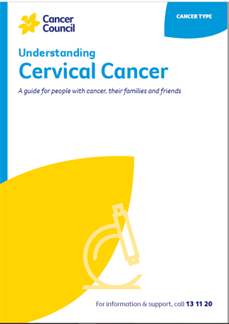- Home
- Cervical cancer
- Diagnosis
- Tests
- Treating precancerous abnormalities
Treating precancerous abnormalities
If any of the tests show precancerous cell changes, you may have one of the following procedures to remove the area of abnormal cells and prevent it developing into cervical cancer.
Learn more about:
Large loop excision of the transformation zone
Large loop excision of the transformation zone (LLETZ) is the most common way to treat precancerous changes of the cervix. The abnormal tissue is removed using a thin wire loop that is heated electrically. The aim is to remove all the abnormal cells from the surface of the cervix. It may also be called loop electrosurgical excision procedure (LEEP).
The procedure is done under local anaesthetic in your doctor’s clinic or under local or general anaesthetic in hospital. A LLETZ takes about 5–10 minutes. The tissue sample is sent to a laboratory for examination under a microscope. Results are usually available in 1–2 weeks.
Side effects of a LLETZ or LEEP
After the procedure, you may have some vaginal bleeding and cramping. These side effects will usually ease in a few days, but you may notice some spotting for several weeks.
See your doctor if the bleeding lasts longer than 3–4 weeks, becomes heavy or has an unpleasant smell, or you develop fever or intense pelvic pain. To give your cervix time to heal and to prevent infection, you should not have sexual intercourse or use tampons for 4–6 weeks after the procedure. Showers are fine, but avoid baths, spas and swimming pools for about 4 weeks as these can increase the risk of infection.
After a LLETZ you can still become pregnant, but you may have a slightly higher risk of having the baby prematurely. Talk to your doctor before the procedure if you are concerned.
Cone biopsy
This procedure is used when the abnormal cells are found in the cervical canal, if a larger area needs to be removed or when early-stage cancer is suspected. In some cases, a cone biopsy is also used to treat very early-stage cancers, particularly if you would like to have children in the future.
A cone biopsy is usually done as day surgery in hospital under general anaesthetic. A surgical knife (scalpel) is used to remove a cone-shaped piece of tissue from the cervix (see Types of surgery for more information). A pathologist examines the tissue to make sure all the abnormal cells have been removed. Results are usually available in 1–2 weeks.
Side effects of a cone biopsy
After a cone biopsy, you may have some light bleeding or cramping for a few days. Avoid doing any heavy lifting for a few weeks, as the bleeding could become heavier or start again.
If the bleeding lasts longer than 3–4 weeks, becomes heavy or has an unpleasant smell, or you develop fever or intense pelvic pain, see your doctor. You may notice a dark brown discharge for a few weeks, but this will pass. To give your cervix time to heal and to prevent infection, you should not have sexual intercourse or use tampons for 4–6 weeks.
A cone biopsy may weaken the cervix. You can still become pregnant after a cone biopsy, but you may be at a higher risk of having a miscarriage or having the baby prematurely. If you would like to become pregnant in the future, talk to your doctor before the procedure.
I had period-like pain for a few days after the cone biopsy but a hot water bottle and mild pain medicines helped a lot.
Julie
Laser surgery
This procedure uses a laser beam instead of a knife to destroy or remove the abnormal cells.
A laser beam is a strong, hot beam of light. The laser beam is pointed at the cervix through the vagina. Laser surgery is done under either local or general anaesthetic. It takes about 5–10 minutes, and you can go home after the treatment when you have recovered from the anaesthetic.
Laser surgery works just as well as a LLETZ to remove precancerous cells and can be a better option if the precancerous cells extend from the cervix into the vagina or if the lesion on the cervix is very large.
Side effects of laser surgery
These are similar to those of LLETZ. You are usually able to return to your usual activities 2–3 days after having laser surgery, but you should not have sexual intercourse or use tampons for 4–6 weeks. You will also need to avoid baths, swimming pools and spas.
Learn more about surgery.
Podcast: Tests and Cancer
Listen to more of our podcast for people affected by cancer
More resources
Prof Martin Oehler, Director of Gynaecological Oncology, Royal Adelaide Hospital, and Clinical Professor, University of Adelaide, SA; Dawn Bedwell, 13 11 20 Consultant, Cancer Council QLD; Gemma Busuttil, Radiation Therapist, Crown Princess Mary Cancer Centre, Westmead Hospital, NSW; Dr Antonia Jones, Gynaecological Oncologist, The Royal Women’s Hospital and Mercy Hospital for Women, VIC; Angela Keating, Senior Psychologist, Royal Hospital for Women, NSW; Anne Mellon, Clinical Nurse Consultant – Gynaecological Oncology, Hunter New England Centre for Gynaecological Cancer, NSW; Dr Inger Olesen, Medical Oncologist, Andrew Love Cancer Centre, Barwon Health, Geelong, VIC; Dr Serena Sia, Radiation Oncologist, Fiona Stanley Hospital and King Edward Memorial Hospital, WA; A/Prof Megan Smith, Co-lead, Cervical Cancer and HPV Stream, The Daffodil Centre, Cancer Council NSW and The University of Sydney, NSW; Emily Stevens, Gynaecology Oncology Nurse Coordinator, Southern Adelaide Local Health Network, Flinders Medical Centre, SA; Melissa Whalen, Consumer.
View the Cancer Council NSW editorial policy.
View all publications or call 13 11 20 for free printed copies.

